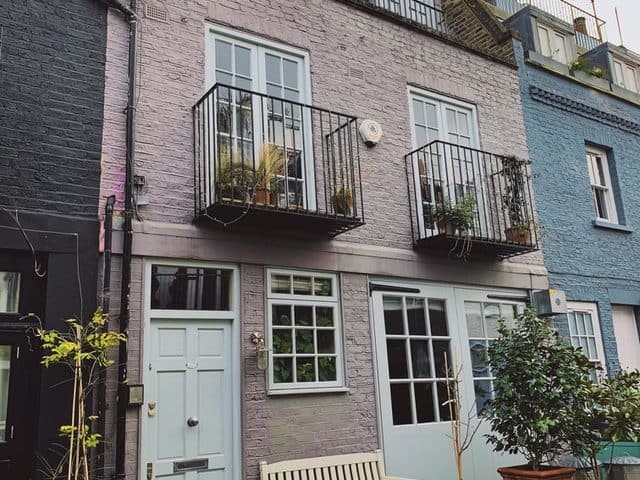
Damp Diagnosis in London
What Causes Damp in a Home?
The average UK home will deal with a large amount of rain throughout the year, so, unsurprisingly, many British properties will suffer from problems with mould and damp. Damp and decay can appear on the internal walls of a home and can be caused by various reasons, from ineffective drains to broken damp proof courses.
Diagnosing Damp Problems – The Age of the House:
Before looking at the causes of damp on internal walls, it’s essential to understand that properties vary depending on their age. Older buildings tend to be designed so that they must be allowed to breathe, while newer buildings are constructed with a system of defensive barriers to keep moisture out.
Installing insulation is usually the best fix for dampness, mould, and condensation. However, there are a few things that you should pay extra attention to if you are insulating an older property, including keeping a vapour control layer for condensation. Sealing an old building will cause it to be warm during the colder months, but this will also lead to ‘sweating’, which results in condensation and damp on the internal walls.
Types of Damp:
Two main types of damp can form on internal walls. These are penetrating damp and rising damp. Rising damp happens when the damp patches grow from the ground level, or where there are powdery deposits on the wall’s surface. This type of damp is usually due to the absence or failure of a damp-proof course. Houses are typically affected by rising damp, and it will not affect flats above ground level. The best way to deal with a rising sticky issue is to improve the drainage around your property, such as making sure that the ground surrounding the building is sloping away from it.
Penetrating damp is another type of damp that occurs when the water penetrates from the outside and goes deep into the brickwork. It may also penetrate through the internal walls through gaps or cracks in the external walls. To prevent damp from penetrating the home, it’s essential to maintain your outer walls regularly. Good wall insulation can also help.
Damp Diagnosis London: Common Causes of Damp
Several different reasons in the home can cause damp. Some of the most common causes of damp include:
Problems with the Damp Proof Course:
This is the primary cause of damp in most residential cases. Rising damp will usually result from a damp proof course that is broken or not present. Check to see where the damp is appearing in the home. This is the likely culprit if it’s present on the walls just above the skirting boards. Rising damp does not usually get to a certain height since gravity will hold it back. If you’re experiencing this type of damp at home, check whether your damp proof course is faulty or bridged.
The damp proof course is a waterproof layer that prevents moisture and water from travelling up the walls in a property. It is usually installed as a vertical course and is situated where the external wall meets the internal wall to prevent the water from travelling.
Plumbing:
Plumbing plays an essential part in the quality and condition of your home, and any drips can lead to intense damp patches. However, plumbing issues can often be hard to spot if they are located in the internal pipes of your home. You may not always realise just how much water is escaping. If there is a regular leak in your plumbing and concentrated on the same spot, it can lead to severe damp patches that can be difficult to repair. In addition, the overload of damp may even make its way into your neighbour’s home depending on where it is located, which can be even more worrying. If you suspect that plumbing problems lead to dampness in your home, you should check your water pipes for any signs of corrosion. Check to see whether there are any damaged seals around bathroom furniture and whether any waste pipes in the bathroom are failing.
Condensation:
Condensation is a common cause of damp on internal walls. Condensation forms when the moist air within a room touches a cold surface such as the external wall. This causes the warm, moist air to cool down, condensing it back into the waThe condensation then sits on the wall, leading to damp patches.
Leaking Gutters:
Another common cause of damp on internal walls is problems with the guttering. If a gutter is leaking, there are only two ways that the water can go. It can either run directly down the outside of the wall or splatter onto the ground and window ledges below. Leaks in the gutter may often leak water into the roof space. If you suspect that you may have a damp problem caused by leaking gutters, check to see if there is any splattering from gutters leaking onto the walls and inspect your roof space for tracks of water tricksters:
Undersized gutters are another gutter-related problem that can lead to damp. This is often a common issue with older homes that were first built with gutters suitable for the amount of rainfall at the time. However, climate change has led to more frequent rain over the years, leaving the gutters unable to cope with the changes due to being too small. If this is a problem in your home, you have the only option is to replace the gutters. You will be able to tell if your gutters are undersized by checking for regular water spilling over the edges.
Downpipes:
Older, cast-iron downpipes can also damp, mainly if they contain bends that increase the risk of blockages. If you suspect that this might be the cause of cause me, check to see if there are any holes in the back of the downpipes and look for water tracking along the brackets f with the pipe.
Home Improvement Jobs and Damp – When to Be Careful:
When carrying out work on your home, it is important to consider the risks involved in damping.
Floor Replacement:
If you plan to replace a solid floor, it is important to be essential concerning damp prevention. This is because the excess moisture below many s can easily pass up into the air. However, if you plan to replace your floors, check used since many modern designs prevent this from happening. As a result, the moisture needs to travel under the floor where it goes into the adjoining walls. This leads to more moisture accumulating in the base of the walls, causing damp.
Cement Rendering:
This type of coating is typically used on wall exteriors. However, the main issue with cement coatings is that they can develop surface cracks. These can vary in size depending on the skill of the contractor and the quality of the render. However, damages are usually impossible to prevent, and they will allow water into the wall that does not have a way to escape. Cement renderinIn addition, cementes condensation from the inside of the property with no way to escape, which can lead to damp on the inside of the walls.
Condensation and Cold Spots – What to Know:
Condensation is more likely to occur when there are cold spots on your walls, and it is essential to identify the problem that is causing them. Sometimes, this could be due to cracks in the mortar or poor ventilation systems in areas of the home, such as the chimney breast.
Solutions for Damp:
Thankfully, there are several solutions that you can use in your home to prevent both rising and penetrating damp from occurring on the internal walls. Insulation is the best way to prevent dampness in your home, and there are two main options to consider. These are:
Wall Insulation:
Designed to insulate bricks and other porous building materials, it will bond with the surface immediately on application and create an invisible insulation barrier in the brickwork. It protects against rain, pollution, algae and more and can be applied to bricks and concrete. It continues to allow the home to breathe so that any condensation from the inside has somewhere to go.
Cavity Wall Insulation:
This type of insulation is typically Rockwool or Spray Foam and is applied to the internal spaces and cavities. It provides your home with an air-tight thermal seal, meaning that the heat stays inside during the winter and that the temperature remains cool in the summer. It is designed to control moisture in the air and can reduce your energy bills.
Various different problems can cause damp in the home. If you have noticed damp on your property, it is best to act quickly as it may spread.
Do You Get Rising Damp in Summer?
Most types of damp are less noticeable in the summer compared to during the winter, when the wet weather is usually increased. This includes rising damp, which is the result of moisture that is sucked up from the ground, through the foundation, and into the walls of the home. While it can happen at any time of year, it is most likely and most noticeable when there are larger amounts of ground water present.
Most materials that are used in building properties, including bricks, blocks, stone, and concrete footings, are porous materials, meaning that they can absorb water through capillary action. As the water table rises with the wetter weather throughout the year, the moisture from the ground begins to rise through the bricks, which suck up the groundwater like a sponge. In most cases, the damp proof course will prevent this from happening. The damp proof course is a water-resistant membrane that spans the length and width of your property, located at around six inches above ground level.
The type of damp proof course that you will have will usually depend on the age of the property. It could be a modern plastic damp proof course, slate, bitumen, or one or two rows of engineering bricks installed below the height of the internal floor level. Having a damp proof course installed when building a new property was made compulsory over a hundred years ago, so it should have one if your property was built after the 1870s. However, if you have an older property built before this time, it might not have a damp proof course.
What Does Rising Damp in Internal Walls Look Like?
Most of the first signs of rising damp will occur in the internal walls. You will be able to see the damp that has risen up from the ground level and through the brick as it is characterised by brown or yellow staining on the internal walls. It might also affect skirting boards and other woodwork with wet rot. Generally, rising damp is only a problem on the ground floor. If you have noticed damp near the skirting boards on a higher floor, then this will usually be the result of penetrating damp, which is a different kind of damp that no damp-proof course is going to stop. Rising dampness is caused by moisture travelling upwards through the bricks or other building materials. Because of this, it will inevitably reach a point where gravity forces it back down. In the case of rising damp, there may be an obvious cut-off where the damp ends at around 1.2 metres from the ground level.
What Causes Rising Damp in Internal Walls?
Rising damp in the internal walls is commonly caused by issues with a damp proof course. If you live in a very old property built before damp proof courses became mandatory when building a property, then there may be no damp proof course present. You can usually check for the presence of a damp proof course by looking at the mortar joint on the external wall at around six inches above ground level.
On the other hand, if your house was built after damp proof courses became mandatory, then chances are that the rising damp has been caused by it failing. Over time, damp proof courses can become less effective, depending on the materials used. Older properties that were built with a damp proof course might still have damp problems now as after all, damp proof courses were made mandatory during the Victorian times, so if you’ve still got the original one, it’s probably no surprise that it might not be doing its job as well any longer.
Finally, if you have a modern and fairly new damp proof course and are still getting rising damp, then the good news is that there is probably nothing wrong with the damp proof course itself. However, the bad news is that something is creating a bridge to allow the moisture to get in above the damp proof course, where it travels up the bricks and leads to damp. There are various reasons why this might happen, including a higher ground level on the exterior of your property. Since your damp proof course is located at around six inches above ground level, ground that is higher than this, such as a patio or decking attached to your property’s exterior wall, could be letting the moisture in. Due to debris, blockages in the cavity wall can also provide a bridge, along with structures close to the property. The bridge will need to be removed in order to stop the rising damp problem, or you may want to have a new damp proof course installed higher up to stop the moisture from getting in.
Finally, your neighbour’s damp proof course might be causing your rising damp if you live in a semi-detached or terraced property. When you share walls with other properties, anything that happens to the shared wall can affect both houses. If your neighbour’s damp proof course has failed or does not have one, this could cause moisture to get into your internal walls and cause rising damp in your property. Similarly, even if your neighbour has a damp proof course, it might be acting as a bridge to yours if they have installed it higher up, which will allow moisture to get in above the damp proof course in your property and cause damp to your walls.
How Can You Fix Rising Damp?
The steps that you will need to take to fix a rising damp problem in your home will depend on the main reason behind it. If you live in a very old property that does not have a damp proof course because it was built before they were made mandatory, for example, then the most obvious thing to do is to have a damp proof course installed. You can have this done by a damp specialist who will use specialised tools to inject a chemical waterproofing solution into the brick at around six inches above ground level to create your new damp proof course, which should stop any further rising damp issues from occurring.
If your damp proof course has failed, it is usually a better option to have a new one installed than trying to repair it. Due to the location of the damp proof course, it is often impossible to carry out repairs, even for a specialist. Along with this, the main reason for a damp proof course failure is age, and if your damp proof course has been around for decades and is wearing out, then any repairs that could be carried out might not even be worth it. Having a brand new damp-proof course installed is always the best course of action to avoid future problems.
If your neighbours have a damp proof course that is higher up than yours, causing moisture to get over your damp proof course and into your walls, then again, having a new damp proof course installed is the best option. Alternatively, your neighbour could have a new damp proof course installed lower, but this might not be an option for everybody, and they may not see a need to if the rising damp is not affecting their property. Having a new damp proof course installed that is at the same level as your neighbours will block off any space in between where moisture has been accessing your walls above the damp proof course.
How to Prevent Rising Damp in the Future
To prevent rising damp in the future, it’s crucial to ensure that your damp proof course is working correctly and be aware of anything that might cause a bridge for moisture. If you are doing any building or gardening work, always be mindful of where your damp proof course is so that you can keep ground levels and structures below it and avoid creating a way for moisture to get over it.
Rising damp can happen at any time of year, but it might be more noticeable in summer than winter. There are several different ways it can happen, but it always involves moisture travelling from the ground and up into the walls.

